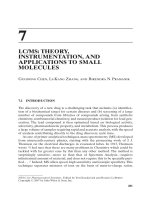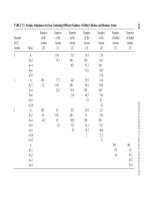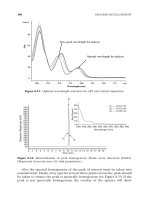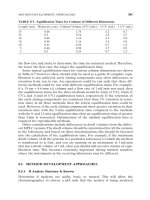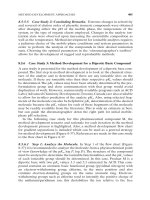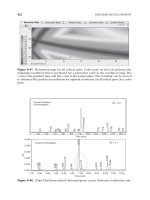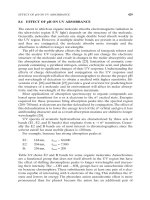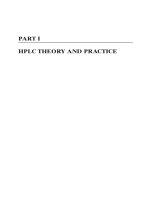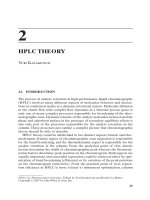Tài liệu HPLC for Pharmaceutical Scientists 2007 (Part 4A) ppt
Bạn đang xem bản rút gọn của tài liệu. Xem và tải ngay bản đầy đủ của tài liệu tại đây (533.78 KB, 34 trang )
4
REVERSED-PHASE HPLC
Rosario LoBrutto and Yuri Kazakevich
4.1 INTRODUCTION
Over 25 years ago, Horvath and Melander, in their fundamental work [1], dis-
cussed the reason behind the explosive popularity of reversed-phase liquid
chromatography (RPLC) for analytical separations. It was estimated that
about 80–90% of all analytical separations were performed in RPLC mode,
and the authors noted that “the variation of eluent composition alone extends
both retention and selectivity in HPLC [high-performance liquid
chromatography] over an extremely broad range.” They compared gas
chromatography with HPLC, citing “in gas chromatography a plurality of
stationary phases has found practical application whereas HPLC tends toward
the use of very limited number of columns and optimization of the separation
by manipulating the composition of the mobile phase.” To some extent the
statement is true even today, except that with introduction of capillary columns
in GC today, only a very limited number of stationary phases are used, while
in HPLC during the last 25 years of development, thousands of different
stationary phases have been introduced. Practically all reversed-phase
separations are carried out on stationary phases with chemically modified
hydrophobic surfaces. Minor variations in the surface chemistry and geome-
try can lead to noticeable differences in surface interactions and, as a result,
to differences in chromatographic selectivity. Specific stationary-phase prop-
erties and their influence on the chromatographic retention, selectivity, and
efficiency are discussed in detail in Chapter 3.
139
HPLC for Pharmaceutical Scientists, Edited by Yuri Kazakevich and Rosario LoBrutto
Copyright © 2007 by John Wiley & Sons, Inc.
Mobile phase (eluent) is by far the major “tool” for the control of analyte
retention in RPLC.Variations of the eluent composition, type of organic mod-
ifier, pH, and buffer concentration provide the chromatographer with a valu-
able set of variables for successful development of a separation method.
Mobile-phase pH affects the analyte ionization and thus its apparent
hydrophobicity and retention. Most pharmaceutical analytes, API (active
pharmaceutical ingredient), in-process intermediates, reaction samples, drug
substances, raw materials, drug products, and other types of samples generated
during the drug development life cycle are ionizable, and their retention
is affected by the mobile-phase pH. At the same time, the pHs of
aqueous–organic mixtures are different from the pH of the aqueous compo-
nent itself. The relationship between measured pH of the aqueous phase and
the actual pH of the eluent will be discussed, and approaches on how to cor-
relate the HPLC retention to actual eluent pH will be elaborated. The influ-
ence of temperature and type and concentration of organic on analyte and pH
modifier ionization and its relation to HPLC retention will also be described.
All the choices the chromatographer has in terms of bonded phase, aqueous
phase modifier, and organic modifier can have synergistic effects on the
analyte retention and selectivity in reversed-phase chromatography. These
parameters will be discussed in this chapter, with specific examples illustrat-
ing the power of the selection of the most suitable parameters for control of
the analyte retention and selectivity.
4.2 RETENTION IN REVERSED-PHASE HPLC
The basis for the analyte retention in reversed-phase chromatography is the
competitive interactions of the analyte and eluent components with the adsor-
bent surface. The stronger the interactions of the analyte with the surface, the
longer its retention. Selectivity or the ability of chromatographic system to dis-
criminate between different analytes is also dependent on differences in the
surface interactions of the analytes.
Historically, reversed-phase chromatography could be traced back to the
work of Howard and Martin [2], who treated an adsorbent surface (of Kisel-
gure) with dimethylchlorosilane followed by coating of this nonpolar surface
with paraffin oil employing methanol–acetone mixtures as the mobile phase.
They treated the retention process as partitioning of the analyte between
the mobile phase and paraffin oil, which served as a stationary phase
(alkylchlorosilane treatment of the polar surface serves only the purpose of
increasing wettability by paraffin oil). For many years the advancement in the
developments in HPLC essentially followed the development of phases used
for gas chromatography. In the middle of the 1960s, modification of the silica
gel surface with hexadecyltrichlorosilane was introduced for GC [3]. Follow-
ing this, Stewart and Perry [4] suggested that this material would be the best
possibility for the advancement of “liquid–liquid” chromatography (the term
140 REVERSED-PHASE HPLC
RPLC was coined). Later, Majors [5] introduced porous silica microparticles
modified with alkylsilanes, a packing material that is almost exclusively used
in reversed-phase HPLC today.
This brief historical overview of RPLC development is far from the full
description of all significant achievements made in the past; however, the
primary goal is to show the path of the development, which was, to a larger
extent, in the tail of GC development. Consequently, the models and the
descriptions of the retention mechanism were essentially transferred from
gas–liquid partition chromatography.
Partitioning describes the transfer of the analyte molecules from one phase
into another, where the phase is an isotropic macroscopic object with definite
physicochemical characteristics. A monomolecular layer of bonded ligands
could not be considered as a phase, although following the terminology widely
accepted in the literature the term stationary phase is used to essentially
denote a solid surface of immobile packing material in the column.
The retention mechanism in modern RPLC is a superposition of different
types of dynamic surface equilibria. Main equilibria governing the analyte
retention is the adsorption of the analyte molecule on the surface of packing
material. The description of the analyte retention on the basis of this main
adsorption equilibrium could be expressed as
(4-1)
where V
0
is the total volume of the liquid phase in the column (void volume),
S is the adsorbent surface area, and K is the adsorption equilibrium constant.
This expression assumes ideal analyte behavior in the chromatographic system
at very low analyte concentration. As follows from equation (4-1), the equi-
librium constant, K, has units of length (i.e., volume/m
2
) and, as such, could
not be used as a general thermodynamic equilibrium constant (unitless), but
rather as a coefficient representing the analyte retention volume per unit of
the adsorbent surface (e.g., µL/m
2
). More general expressions and detailed
adsorption-based description of the analyte retention in reversed-phase
HPLC is given in Chapter 2 of this book.
While dynamic distribution of the analyte between the mobile phase and
adsorbent surface is a primary process, there are many secondary processes in
the chromatographic system that significantly alter the overall analyte reten-
tion and selectivity. Detailed theoretical discussion of the influence of sec-
ondary equilibria on the chromatographic retention is also given in Chapter 2.
The analyte nature and its appearance (e.g., ionization state) in the mobile
phase are also factors that affect the retention mechanism. Eluent pH influ-
ences the analyte ionization equilibrium. Eluent type, composition, and pres-
ence of counterions affect the analyte solvation. These equilibria are also
secondary processes that influence the analyte retention and selectivity and
are of primary concern in the development of the separation methods for most
pharmaceutical compounds.
VVSK
R
=+
0
RETENTION IN REVERSED-PHASE HPLC 141
This brief descriptive overview of the reversed-phase process emphasizes
the complexity of the retention mechanism and the necessity to consider the
influence of different and independent processes on the analyte retention.
Since the governing process in the analyte retention is the adsorption equi-
librium, the influence of the surface packing material (stationary phase) on
the analyte retention in RPLC is described in Section 4.3.
4.3 STATIONARY PHASES FOR RPLC
The introduction of chemically modified stationary phases has had a remark-
able impact in the field of liquid chromatography. Successful development and
improvement in the technology of manufacturing reproducible bonded layers
has revolutionized many chromatographic techniques. Porous silica stationary
phases have been modified with ligands of various chemistry and size. The
composition and the structure of the bonded organic layer is varied by chang-
ing the size of the modifier, specific surface area of the adsorbent, and the
bonding density. Chemical bonding of organic ligands with high bonding
density on the inner surface of silica pores alters the adsorbent geometry. The
effect of surface modification on adsorbent geometric parameters (surface
area, pore volume, pore size) has been investigated on several different silica
gels [6–8]. It was shown that a decrease in mean pore diameter and in pore
volume are associated with the molecular volume of bonded ligands and
bonding density. Similar effects were also observed by other researchers [9,
10] Clearly, surface modification has a significant impact on the adsorbent
geometry of reversed-phase columns, which will also influence the separation
mechanism itself [11]. These effects are discussed in detail in Chapter 3.
Silica-based packing materials dominate in applications for RP separations
in the pharmaceutical industry. Hydrophobic surface of these packings typi-
cally are made by covalent bonding of organosilanes on the silica surface. This
modification involves the reaction of monofunctional alkyldimethylchlorosi-
lanes with the surface silanol groups. Octadecylsilane was the first commer-
cially available silica-based bonded phase and is still the most commonly
utilized [12].Also, alkyl-type ligands of different number of carbon atoms (C1,
C4, C8, C12) are often used as well as phases with phenyl functionality; also,
polar end-capped, polar embedded phases have been introduced [13–15]. Polar
embedded phases provide an additional avenue for potential modification of
the chromatographic selectivity, and some of these phases offer an enhance-
ment of retention of polar analytes [16]. These phases can be used with high
aqueous mobile phases, even 100% aqueous, without loss of analyte retention
that sometimes could be observed for more hydrophobic phases.
Screening several different types of stationary phases during method devel-
opment for a particular separation is often useful because different columns
usually have different selectivity for components in a sample, as can be seen
for a forced degradation sample analyzed on three different types of reversed-
142 REVERSED-PHASE HPLC
phase columns using 0.1 v/v% TFA (Figure 4-1) and phosphate buffer, pH 7
(Figure 4-2) mobile phases. Mobile-phase pH can also provide an alternate
means of varying the separation selectivity as well.
Other silica-based phases that are available include phenyl and fluorinated
alkyl and phenyl-bonded phases. The phenyl and fluorinated phases offer the
potential for π–π interactions and show different selectivity in comparison to
STATIONARY PHASES FOR RPLC 143
Figure 4-1. Effect of column type on selectivity. Mobile phase: Low pH. (A) 0.1 v/v %
TFA. (B) 0.1 v/v% TFA in MeCN. Linear gradient from 5% B to 80% B in 40min,
220 nm. Temperature, 40°C; flow rate, 1.0 mL/min; column dimensions, 150 × 3.0 mm;
particle sizes, 3.5µm for Symmetry Shield and Atlantis and 3.0µm for YMC ODS AQ.
(Courtesy of Markus Krummen, Novartis Pharmaceuticals.)
Figure 4-2. Effect of column type on selectivity. Mobile phase: High pH. (A) 10 mM
K
2
HPO
4
, pH 7.0. (B) In MeCN, linear gradient from 5% B–80% B in 40 min, 220 nm.
Temperature, 40°C; flow rate, 1.0 mL/min; column dimensions, 150 × 3.0 mm; particle
sizes, 3.5µm for Symmetry Shield and Atlantis and 3.0µm for YMC ODS AQ. (Cour-
tesy of Markus Krummen, Novartis Pharmaceuticals.)
the alkylsilane phases [17–21]. The fluorinated phases have shown some size
and shape selectivity, particularly for aromatic molecules [22, 23]. Moreover,
with phenyl-type phases, selectivity/separation differences could be obtained
when methanol or acetonitrile is employed. Acetonitrile is an electron-rich
organic modifier, which could modify the π–π interactions between the solute
and the aromatic moiety of the stationary phase. Methanol, on the other hand,
is a proton donor and does not contain π electrons, and therefore its influence
on the analyte retention would be principally different [24–26]. It is generally
recognized that the type of organic eluent modifier employed plays a domi-
nant role in separation selectivity, although the mechanism of its influence on
the analyte retention still remains a subject of intense investigation.
Most silica-based reversed-phase packing materials have a relatively
narrow applicable pH range. Below pH 2, the linkage of the bonded phase to
the silica substrate is prone to hydrolytic cleavage. Above pH 7, the silica sub-
strate is prone to dissolution, particularly in aqueous-rich mobile phases. In
addition, basic compounds may exhibit peak asymmetry above pH 3 due to
secondary interactions between the ionized form of the solute and accessible
residual silanols. Some new developments in column chemistry have been
adopted to address the issues of limited pH working range and reduction of
surface density of silanols. The use of hybrid materials allowed for the intro-
duction of organic bridged silica in which an organic bridge is formed between
silicon atoms. Resulting hybrid material have been claimed by vendors to show
better pH stability at pHs >7 since Si–C covalent bond is much less prone to
hydrolysis than Si–O–Si bonds. However, the stability of phases depends on
many factors such as the operating pH, type, and concentration of organic
modifier and salt concentration, operating temperature, and operating back-
pressure. Another approach to manufacturing hybrid silica (Gemini) was
introduced by Phenomenex. A layered hybrid silica is synthesized such that
the core of the particle is regular silica and the surface is covered by a layer
of organic-embedded silica also lending itself to greater pH stability.These sta-
tionary phases are further discussed in Chapter 3.
The narrow pH stability range of silica-based packing materials leads to the
continuous search for alternative packings that may provide greater pH sta-
bility. The options include polymer-based, zirconia-based, and carbon-based
phases.The polymer-based columns include poly(styrene-divinyl benzene) and
divinylbenzenemethacrylate. These polymer-based columns tend to be stable
in the pH 0–14 range. However, lower efficiencies on these polymeric columns
relative to silica-based columns are usually obtained due to slower mass trans-
fer kinetics. These phases are also prone to swelling/shrinking as a function of
the mobile-phase composition. Retention and selectivity is based on a combi-
nation of hydrophobic and π–π interactions [27]. Zirconia is nearly insoluble
at pH 1–14 and is stable at temperatures greater than 150°C. The zirconia
surface is positively charged up to pH ∼ 8, after which it becomes negatively
charged [28]. Surface charge, however, is also influenced by adsorption of
mobile-phase anions that are hard Lewis bases. The adsorption of hard Lewis
144 REVERSED-PHASE HPLC
bases such as phosphate ion results in ion-exchange sites offering different
selectivities than silica [29, 30]. A comparison of polybutadiene (PBD)-coated
zirconia and octadecylsilane (ODS) phases indicated that ion exchange is the
dominant interaction for basic solutes on the PBD phases while hydrophobic
interactions dominate on the ODS phases when phosphate is in the mobile
phase [31]. Carbon-based columns are chemically stable over pH range 1–14.
These phases are very hydrophobic compared to alkylsilane phases and thus
are useful for the separation of polar compounds. However, they strongly,
sometimes irreversibly, retain very hydrophobic solutes. Graphitized carbon
phases are very suited for the separation of positional and conformational
isomers, since the majority of their surface is an ideal graphite plane. Porous
graphitized carbon consists of multiple graphite microcrystals and thus offers
significant difference in the planar interactions for conformational isomers.
Intercrystalline dislocations (irregularities in the crystalline structure), on the
other hand, are places of higher surface energy and because the whole mate-
rial is a conductor, they can be chemically active, which reduce column life-
time and should be taken into account if chemically labile compounds should
be separated.
4.4 MOBILE PHASES FOR RPLC
Mobile phases commonly used in reversed-phase HPLC are hydro-organic
mixtures. The most common reversed-phase organic modifiers include
methanol and acetonitrile and/or combinations of these two modifiers. Other
mobile-phase modifiers such as tetrahydrofuran, IPA, and DMSO [32] have
been also used for minor selectivity adjustment; however, they are not
common due to their high backpressure limitations and/or high background
UV absorbance.
The concentration of organic modifier in the eluent is the predominant
factor that governs the retention of analytes in RPLC. Highly purified solvents
(HPLC grade) are recommended in order to minimize contamination of the
stationary phase with impurities of the solvents and reduction of the back-
ground absorbance if they contain impurities that have UV chromophores
>190 nm.
Considerations for choice of mobile-phase solvents include compatibility
between solvents, solubility of the sample in the eluent, polarity, light trans-
mission, viscosity, stability, and pH. The mobile-phase solvents should be mis-
cible and should not trigger precipitation when they are mixed together. For
example, dichloromethane and water are immiscible at most compositions and
should not be used as mobile-phase components. Similarly, high concentra-
tions of phosphate buffer should not be used with high levels of acetonitrile
because the phosphate will eventually precipitate out, resulting in damage
in the pump head and blockage of the column frit. The sample should also
be soluble in the mobile phase to avoid precipitation in the column. Light
MOBILE PHASES FOR RPLC 145
transmission is an important parameter when using UV detection; see Table
4-1 for UV cutoffs of common reversed-phase organic modifiers.
Solvents with high UV cutoffs such as acetone (UV cutoff 330 nm) and ethyl
acetate (UV cutoff 256 nm) cannot be used for analyses at low wavelengths
such as 210 nm. Acetonitrile has a very low UV cutoff (<190 nm) and is one of
the contributing factors toward its common use as a solvent for reversed-phase
separations. Methanol, ethanol, and isopropanol have a UV cutoff of <205 nm,
and at higher organic concentrations the mobile phase transmits less light. It
is generally recommended to work at wavelengths >210 nm with these solvents.
Also the viscosity of the mobile phase plays an important role in the back-
pressure generated in the HPLC column (pressure drop). The viscosity is not
a linear function and is dependent upon the type and concentration of the
organic solvent as well as the operation temperature (Figures 4-3 and 4-4)
[33–35]. Also, highly viscous solvents such as methanol and isopropanol can
lead to reduced diffusion rates, resulting in peak broadening as well as creat-
ing excessively high backpressures in the column. Solvents such as tetrahy-
drofuran (THF) and other ethers are prone to oxidation to form peroxides.
These peroxides can react with the solute or with other mobile-phase compo-
nents, causing the appearance of spurious peaks.
4.4.1 Eluent Composition and Solvent Strength of the Mobile Phase
HPLC retention is sometimes explained as the result of competitive interac-
tions of the analyte and eluent molecules with the stationary phase. From this
point of view the stronger the eluent interactions with the adsorbent surface,
the lower the analyte retention, which leads to the term “eluent strength.”
In the development of reversed-phase separation methods the organic part
of the eluent is considered the strong solvent. Increasing the fraction of the
146 REVERSED-PHASE HPLC
TABLE 4-1. Lower Wavelength Limit of UV
Transparency
a
for the Most Typical Solvents Used in
HPLC
Solvent UV Cutoff
Acetonitrile 190
Isopropyl alcohol
b
205
Methanol 205
Ethanol
b
205
Uninhibited THF 215
Ethyl acetate
b
256
DMSO
b
268
a
Usually determined as the wavelength at which the absorbance
of the neat solvent in a 1-cm cell is equal to 1 AU (absorbance
unit) with water used as reference.
b
Uncommon reversed-phase solvent, may be used in small quan-
tities to adjust selectivity.
MOBILE PHASES FOR RPLC 147
Figure 4-3. Viscosity as a function of organic/water composition values obtained from
references 33–35.
Figure 4-4. Viscosity as a function of acetonitrile/water composition from 15°C–55°C.
Values obtained from references 33–35.
organic solvent increases the solvent strength and allows for elution of the
species in a mixture, resulting in smaller analyte retention factors or retention
volumes.
Analyte HPLC retention is a competitive process, and in an ideal form
assuming only analyte–eluent competition for the stationary phase surface and
in the absence of any secondary equilibria, one can write
(4-2)
where K is a thermodynamic equilibrium constant, which can be expressed as
(4-3)
where ∆G
analyte
is the free Gibbs energy of the analyte interaction with adsor-
bent surface and ∆G
eluent
is the corresponding free Gibbs energy for eluent.
Assuming that the aqueous portion of the reversed-phase eluent is inert and
does not interact with the reversed-phase surface, along with using the prin-
ciple of energetic additivity, one can assume that the free Gibbs energy of the
eluent interaction with the stationary phase is proportional to the concentra-
tion of organic modifier in the mobile phase.
(4-4)
where ∆G
el
is the free Gibbs energy of the interaction of neat organic phase
with the surface, c
org.
is the current concentration of organic modifier in the
mobile phase, and c
max
is molar concentration of neat organic phase. Substi-
tuting equations (4-4) and (4-3) into equation (4-2) and taking the logarithm
leads to equation (4-5):
(4-5)
where are constants and
the logarithm of retention factor is a linear function of the eluent composi-
tion. Note that this is only applicable in the absence of secondary equilibria
effects, which will be discussed later in this chapter.
Therefore, increasing the concentration of the organic modifier generally
leads to an exponential decrease in the analyte retention volume. The general
rule of thumb is that for every 10 v/v% increase in organic modifier there is a
two- to threefold decrease in the analyte retention factors for analytes with
molecular weights of less than 1000 Da. Figure 4-5.
A G RT S V B G c RT=+
()
=∆∆
analyte el
andln
max0
ln ln
.
max
.
k
G
RT
S
V
c
G
cRT
ABc
()
=+
−=+
∆
∆
analyte
org
el
org
0
∆∆G
c
c
G
eleluent
org
=⋅
.
max
K
GG
RT
=
−
exp
∆∆
analyte eluent
k
VV
V
S
V
K
R
=
−
=
0
00
148 REVERSED-PHASE HPLC
The logarithm of the retention factor (k) versus the organic composition is
usually taken to be almost linear over a limited range in reversed-phase
systems (see Figure 4-6). In the eluent concentration region between 50% and
80% of organic component, the slopes of the retention of homologous com-
pounds were the same for all homologs. However, if a wider organic eluent
concentration region is studied as in Figure 4-7, a nonlinear dependence of
logarithm of retention factor versus the organic composition is observed.
The dependence of k (retention factor) on the volume percentage of the
modifier is a subject of great controversy. One school of thought claims a linear
dependence [36, 37], whereas another advocates a quadratic relationship [38,
39] and indicates that deviation from linearity will be more pronounced at high
concentrations of the modifier.
Several different theories have been proposed for the description of the
influence of the eluent composition on the analyte retention in reversed-phase
MOBILE PHASES FOR RPLC 149
Figure 4-5. Retention volume versus % acetontirle composition. Chromatographic
conditions: column, 15cm × 0.46cm Zorbax Eclipse XDB-C8; eluent, 0.1% H
3
PO
4
50–80% MeCN; flow rate, 1 mL/min; temperature: 25°C.
ln k
Figure 4-6. Logarithm of capacity factor versus % acetonitrile composition. (Condi-
tions same as in Figure 4-5.)
HPLC. Probably the very first consistent theory was introduced by Soczewin-
ski [40, 41] for normal-phase separations. He suggested the equation which in
the simplified form reads
(4-6)
where k
2
is the hypothetical extrapolated retention factor for the analyte
eluted with pure solvent 2 (strongest solvent), S is an adsorbent surface area,
and x is a molar fraction of the second eluent component. Almost at the same
time, Snyder [36] introduced the concept of eluotropic strength essentially on
the basis of the correlation with Hildebrand solubility parameter. The influ-
ence of eluotropic strength, ε, of an eluent retention factor was suggested in
the form
(4-7)
where C is a complex function of molecular volumes and molecular areas of
the eluent components.
Later, Snyder et al. [42] introduced simplified semiempirical equation
(4-8)
log logkkS
w
()
=
()
−φ
ln ln lnkkA C
ww
()
=
()
+−
()
+εε
0
ln ln lnkkSx
()
=
()
−
()
2
150 REVERSED-PHASE HPLC
Figure 4-7. Logarithm of the retention factor of alkylbenzenes on Kovasil-C16 (non-
porous silica) as a function of the acetonitrile content.
where k
w
is the extrapolated analyte retention factor in pure water, f is the
volume fraction of the organic eluent modifier, and S is the slope of this linear
function specific for a particular organic modifier used and the nature of the
solute (most important is the molecular weight). For small molecules the S
values for methanol and acetonitrile are generally in the range of 3–4 [43], and
for biomolecules they are more than 50. It later appears that S values are not
exactly solvent-specific but rather dependent on the type of column used.
Horvath and Melander indicated very strong dependence of the S parameter
on the type of the bonded phase [44].
In a simplified form, it is generally accepted that the logarithm of the reten-
tion factor shows linear variation with the volume fraction of the eluent com-
position [45] similar to expression (4-5) above. This statement has to be taken
only as a first and very rough approximation, since many deviations from this
rule have been reported [46, 47] especially for acetonitrile/water mixtures as
shown for n-hexanol and n-octanol in Figure 4-8 [47] and phenol and toluene
in Figure 4-9.
From a practical point of view, the concept of linearity of the logarithm of
the analyte retention factor could be used only for the rough estimation of the
eluent composition variation. Also, the curvature of this dependence can show
further deviations from linearity if the analyte is changing its ionization state
at varying organic composition.
4.4.2 Type of Organic Modifier
Mobile-phase strength depends not only on the concentration of the organic
modifier, but also on the type of organic modifier used. There were many
attempts to create some type of mathematical correlation between the ace-
tonitrile and methanol and THF concentrations which is supposed to result in
similar retention of the analytes. More comprehensive estimates of sliding
scales of solvent strength of different organic modifiers have been given by
Schoenmakers et al. [48, 49] This is known as the same elutropic strength. The
solvent strength of the most common organic eluents used at the same volume
percentage (v/v%) in reversed-phase chromatography would be: methanol <
acetonitrile < tetrahydrofuran. For example, if a similar retention of a neutral
compound or an ionizable compound in its fully ionized or neutral state is to
be achieved with methanol/water eluent compared to acetonitrile/water eluent
on a C18 adsorbent, then an increased concentration of methanol is needed
in the mobile phase (about 10 v/v% more of methanol for every 1 v/v% of ace-
tonitrile would be needed for similar elution). If similar retention is to be
achieved with acetonitrile/water mobile phase versus THF/water mobile phase
on a C18 adsorbent, approximately 10 v/v% more of acetonitrile is needed for
every 1 v/v% of THF. Note that these general rules serve only as an approxima-
tion because the retention of an analyte in methanol/water versus acetonitrile/
water system may be dependent on many parameters lending to different
interactions of the analyte with the solvent and/or with the bonded phase.
MOBILE PHASES FOR RPLC 151
